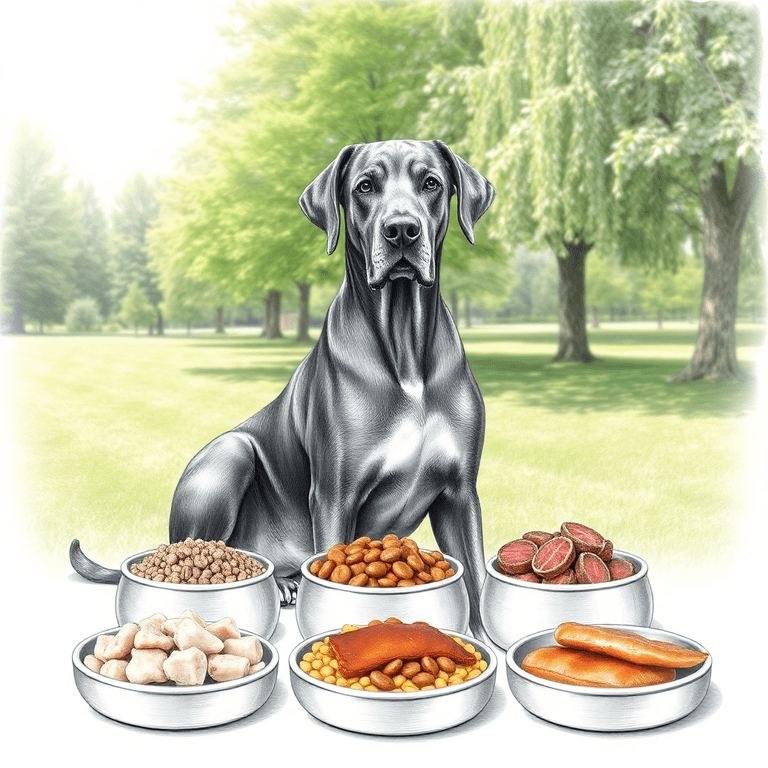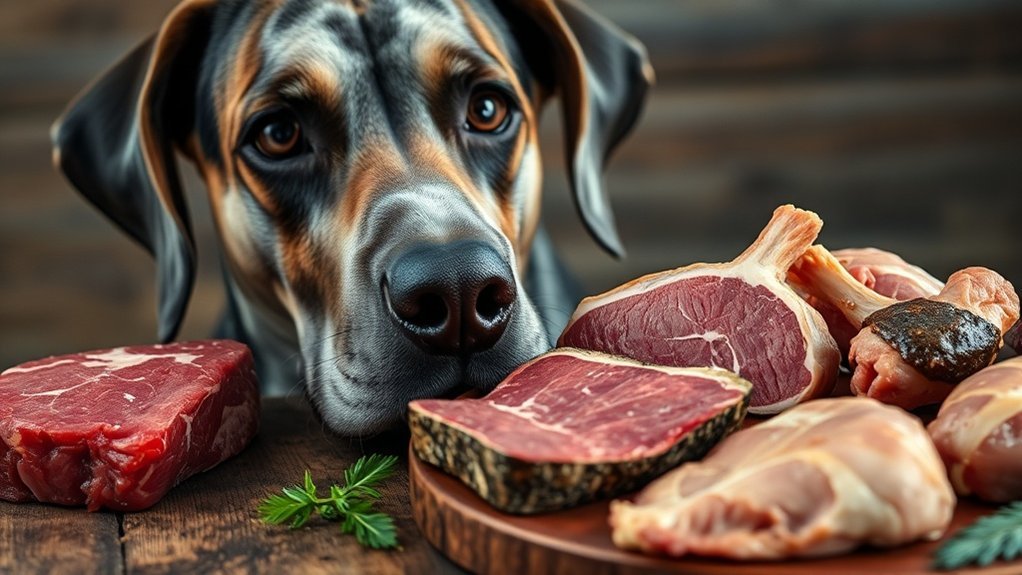Best Meat for Great Dane

We Great Danes need delicious meat to keep our giant bodies happy and healthy. The best choices for us are chicken, beef, and fish. These meats give us all the special building blocks called amino acids that help our muscles grow big and strong (and boy, do we need strong muscles to carry around all this Great Dane greatness!).
Chicken is like our superhero protein – it’s packed with everything we need to stay energetic for those important daily activities like napping, eating, and looking majestic. Beef is our power food that gives us the strength to knock over coffee tables with our enthusiastic tail wags accidentally. And fish? Well, that’s our brain food that helps us figure out how to open treat containers when our humans aren’t looking.
When we eat these high-quality proteins, we stay at the perfect weight (which for us is roughly the size of a small pony). Good meat also keeps our coats shiny, our energy up, and our tails wagging at maximum speed. Plus, it tastes way better than those questionable things our humans try to feed us sometimes.
So remember, fellow four-legged friends – demand the good stuff! Your giant body deserves the best fuel possible.
Importance of High-Quality Protein Sources
Well, we need a balanced diet to keep us healthy and happy. The most important thing in my food bowl is high-quality protein, and trust me, I can tell the difference between the good stuff and the cheap kibble!
So what makes protein “high-quality” anyway? First, it needs to have all the right amino acids – think of them like building blocks for my massive muscles. I also need protein that’s easy to digest because nobody wants a gassy Great Dane, am I right?
And please, no weird fillers that take up space in my already enormous stomach!
When my humans pick out my food, I’m hoping they choose real meat from good sources. This isn’t just me being picky (okay, maybe a little) – it’s because quality protein helps me build strong muscles, gives me energy to zoom around the yard, and keeps my immune system tough enough to handle all those belly rubs from strangers. Additionally, it’s crucial to ensure a balanced calcium and phosphorus ratio for my bone health as I grow!
The cool thing about good protein sources is that they also have essential fatty acids. These keep my coat shiny and my skin healthy, which is important when you’re as gorgeous as me!
Bottom line: choosing the right protein isn’t just about filling my food bowl – it’s about keeping me healthy and happy for all my years of being your lovable giant companion!
Best Animal Proteins for Growth and Development
The Best Animal Proteins for My Growth and Development
First up is chicken – and boy, do I love it! This tasty meat is packed with amino acids that help build my muscles. When my humans give me high-quality chicken, my body can easily digest it and use all those nutrients to make me stronger. It’s like fuel for my growing body!
Beef is another winner in my food bowl. This protein powerhouse helps me build the muscles I need to support my large body. Plus, it tastes incredible! My tail starts wagging just thinking about it.
Don’t forget about fish – it might smell funny to humans, but I think it’s delicious! Fish gives me different nutrients than chicken and beef, so eating a variety keeps my diet interesting and balanced.
My humans are smart and choose lean cuts of meat for me. That means less junk and more of the good protein I actually need. No fillers or weird additives – just pure, muscle-building goodness!
Eating these different proteins helps me maintain the perfect body condition for a Great Dane. I’m not too skinny or too chunky – I’m just right! Additionally, my diet includes high-quality protein sources that support my overall health and development.
This variety in my diet sets me up for a long, healthy, and happy life of being everyone’s favorite gentle giant.
The Role of Fat in Meat Selection
The Role of Fat in Meat Selection
So here’s the scoop on fat: it’s actually pretty essential for us to big dogs. When my humans pick out meat for me, they need to consider the fat content. Fat gives me energy to run around the yard, chase squirrels (okay, I’m too lazy actually to catch them), and play with my toys.
It also helps keep my muscles strong, which is super important when you’re as big as me! The good fats in meat make my coat all shiny and soft. My humans love to pet me when my fur looks good – bonus belly rubs for me! These healthy fats also keep my skin from getting dry and itchy. Nobody wants a scratchy Great Dane, trust me.
But here’s the thing – too much fat can make me chunky, and being overweight isn’t fun when you’re already huge like me. My joints don’t like carrying extra weight, and neither does my heart. Plus, my humans give me those disappointed looks when I can’t see my paws anymore.
The trick is finding meat with just the right amount of fat. Not too little (boring!), not too much (oops, can’t fit through the dog door). When my humans get this balance right, I feel amazing, look great, and have enough energy to protect the house from dangerous things like the mailman and suspicious squirrels. High-biological-value proteins in meat help ensure that I get the energy I need without the extra weight.
It’s all about that perfect fat balance to keep this gentle giant happy and healthy!
Nutritional Considerations for Large Breeds
What This Great Dane Knows About Eating Right
Us gentle giants need special grub that’s different from what those tiny Chihuahuas eat. I mean, have you seen how small they are? I could accidentally step on one! But seriously, our big bodies need big nutrition, and that means being smart about what goes in our bowls.
First up – calories. I know, I know, nobody likes talking about calories, not even dogs. But here’s the thing: just because I’m huge doesn’t mean I should eat like I’m training for a hot dog eating contest. Too many calories make me chubby, and trust me, nobody wants to see a Great Dane trying to squeeze through a doggy door when he’s packed on extra pounds. My humans have to watch my portions so I stay lean and mean (well, lean and friendly).
Next, let’s chat about protein. My muscles are huge, so I need good protein to keep them strong. Think of it like fuel for a monster truck – you can’t put regular gas in there and expect it to crush cars, right? The same goes for my muscles.
Now here’s something cool – my joints need extra love because they’re working overtime holding up all this magnificence. That’s where fancy stuff like glucosamine and omega fatty acids comes in. I can’t pronounce them either, but they keep my joints happy so I can keep doing my favorite things like running in the yard and accidentally knocking over small children with my tail. Glucosamine and chondroitin are essential for joint support, especially for a giant like me!
Oh, and can we talk about kibble size for a second? Those tiny pieces that small dogs eat? Please. I’d need to eat about a thousand of those things just to feel like I’d a snack. Big kibble pieces are perfect for me – they make me actually chew my food instead of inhaling it like a vacuum cleaner. Plus, it’s way more fun to crunch on something substantial.
The bottom line is this: good nutrition keeps me healthy and happy throughout my whole life. And since I plan on being the best, most lovable giant dog around for many years to come, I’m pretty serious about eating right.
After all, someone’s got to keep all those smaller dogs in line, and that someone is me!
Now, if you’ll excuse me, I think I hear my food bowl calling my name.
Recommended Feeding Practices for Optimal Health
First things first – we LOVE our food routine! My humans have figured out that feeding me two or three times a day works way better than dumping a mountain of kibble in my bowl once. Trust me, I’ve tried the “eat everything at once” approach, and let’s say it didn’t end well for anyone involved.
Spreading out our meals helps our stomachs feel good and keeps our energy steady throughout the day.
Now, here’s something that might surprise you – we actually need our humans to measure our food! I know, I know, it sounds crazy coming from a dog who could probably eat a whole pizza (don’t tell my vet I said that).
But the truth is, even though we’re huge, we can get chunky if we overeat.
My humans are constantly checking my weight and adjusting my portions. Sometimes I give them my best puppy dog eyes when they cut back my food, but deep down I know they’re looking out for me. A healthy Great Dane is a happy Great Dane!
And can we talk about the good stuff? High-quality meat makes everything better! It’s like the difference between eating cardboard and eating a five-star meal.
When my bowl has real meat in it, my coat gets shinier, I’ve more energy for zoomies, and I just feel amazing overall. Plus, proper nutrition is essential for preventing common genetic conditions that can affect our health.
Final Thoughts
Woof! Let me tell you about the good stuff – MEAT! As a Great Dane who knows a thing or two about eating (trust me, I’m an expert), I’ve figured out that quality meat is like the best toy ever, except way more delicious, and it keeps me healthy, too.
You see, us Great Danes are gentle giants who need the right fuel to keep our massive bodies running. Think of good meat like premium gas for a fancy car – except the car is me and I’m much more handsome than any vehicle! When my humans give me high-quality protein and healthy fats, I feel like I could leap tall buildings in a single bound. Well, maybe just hop over the couch without knocking anything over.
Finding the right meat isn’t just about filling my gigantic food bowl (though I do appreciate when it’s really, really full). It’s about staying strong and energetic enough to protect the house from dangerous threats like the mailman and suspicious squirrels. With the proper nutrition, I’m not just a big dog – I’m a magnificent, tail-wagging machine ready to give the best slobbery kisses and steal hearts wherever I go!
References
-
- https://americannaturalpremium.com/breed-guide/great-dane-dietary-needs-and-feeding-guide/
- https://www.prodograw.com/raw-feeding-guide/great-dane-feeding-guide/
- https://www.dogster.com/dog-nutrition/how-much-food-does-a-great-dane-need
- http://www.greatdanerescue.com.au/Docs/diet_section.pdf
- https://www.petmd.com/dog/breeds/great-dane







3 Comments